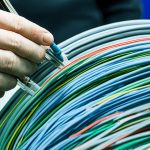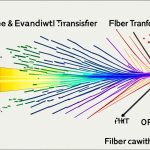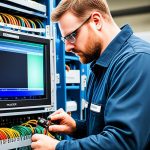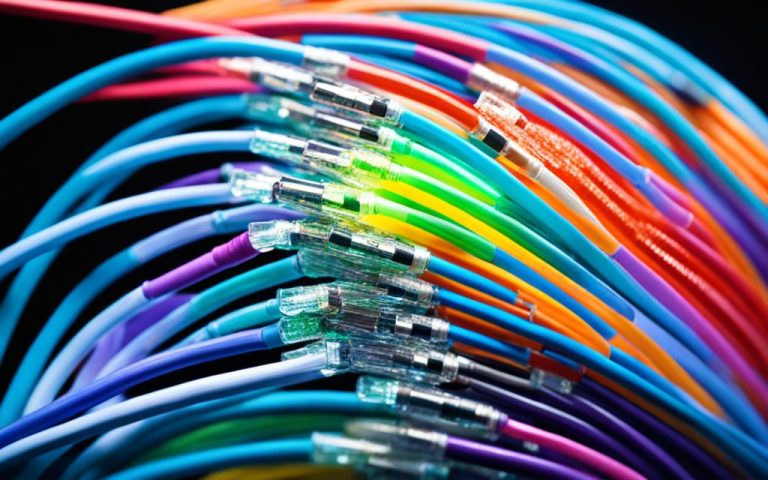In a world where network reliability is crucial for business success, proactive network uptime monitoring has become increasingly important. Businesses of all sizes rely on fiber optic network monitoring to ensure the smooth operation of their networks. This section will explore advanced monitoring techniques for fiber optic networks, including the importance of network uptime monitoring, its benefits, and the tools and strategies involved.
With the ever-increasing reliance on digital connectivity, businesses cannot afford to overlook the importance of network uptime. Downtime can have severe consequences, such as disrupted operations, frustrated customers, and financial losses. By implementing advanced monitoring techniques, businesses can stay one step ahead, proactively identifying and resolving network issues before they cause significant disruptions.
Network uptime monitoring involves continuous monitoring of the network infrastructure, ensuring that all components are functioning optimally. By keeping a watchful eye on the network, businesses can detect potential issues early on and take corrective measures to avoid downtime.
Through proactive monitoring, businesses can achieve high network uptime, guaranteeing seamless operations and enhancing customer satisfaction. Additionally, advanced monitoring techniques enable businesses to identify areas for improvement, optimize network performance, and make data-driven decisions for network infrastructure upgrades.
This section will delve into the various aspects of fiber optic network monitoring, including the tools and technologies used, best practices, and the competitive advantage it offers. By the end of this section, readers will have a comprehensive understanding of the role and significance of advanced monitoring techniques in ensuring network uptime for fiber optic networks.
The Power of Proactive Network Uptime Monitoring
Proactive network uptime monitoring is the key to maintaining business continuity, enhancing customer satisfaction, and driving growth. By implementing proactive strategies and best practices, businesses can stay ahead of network issues and ensure a reliable and high-performing network infrastructure. In this section, we will explore the tools, strategies, and best practices that can help businesses achieve optimal network uptime.
The Importance of Availability Tracking and Performance Metrics
Availability tracking and performance metrics are essential components of proactive network uptime monitoring. By continuously monitoring network availability and performance, businesses can identify potential issues before they escalate into major problems. Key performance indicators (KPIs) such as response time, latency, and packet loss can provide valuable insights into network health and help businesses take proactive measures to maintain uptime.
The Role of Alerting and Notification Systems
Alerting and notification systems play a crucial role in proactive network uptime monitoring. By setting up automated alerts and notifications, businesses can quickly identify and respond to any network issues. This allows for prompt action to be taken, minimizing downtime and ensuring uninterrupted operations. Proactive issue resolution can make all the difference in maintaining network uptime and preventing potential disruptions.
Downtime Detection and Response
Effective downtime detection is another vital aspect of proactive network uptime monitoring. By utilizing advanced monitoring tools, businesses can rapidly detect any network outages or performance degradation. Implementing real-time monitoring solutions enables businesses to respond promptly to downtime events, minimizing their impact on operations and customer experience.
Logging and Reporting for Insights
Logging and reporting are essential for gaining valuable insights into network uptime and performance. By analyzing logs and reports, businesses can identify patterns and trends, enabling them to make informed decisions and optimizations. Regular reporting can also help with compliance requirements and provide evidence of network uptime for stakeholders.
Automation for Streamlined Network Management
Automation plays a significant role in ensuring high network uptime. By automating routine tasks such as configuration backups, software updates, and network device monitoring, businesses can reduce the risk of human error and improve overall network efficiency. Automation enables IT teams to focus on strategic initiatives rather than repetitive manual tasks.
“Proactive network uptime monitoring is the foundation of a well-maintained network infrastructure. By leveraging the right tools, strategies, and best practices, businesses can optimize their network performance and stay ahead of potential issues.”– Network Solutions Expert
By adopting proactive network uptime monitoring practices, businesses can mitigate risks, enhance customer satisfaction, and drive growth. With the right tools and strategies in place, network downtime can be minimized, ensuring consistent and reliable network performance.
In the next section, we will explore the crucial aspects of ensuring physical security for data centers, including access control systems, video surveillance, and more.
Ensuring Physical Security for Data Centers
Data center physical security is of utmost importance when it comes to protecting valuable data and maintaining operational integrity. In this section, we will explore essential methods and measures for ensuring the physical security of data centers. From access control systems to video surveillance and monitoring, perimeter security to security personnel, and environmental control, each component plays a crucial role in safeguarding the data center environment.
Access Control Systems: The First Line of Defense
Access control systems form the first line of defense in data center physical security. These systems utilize various identification methods, such as keycards, biometric authentication, or PIN codes, to restrict unauthorized access to sensitive areas. By implementing access control systems, data center operators can ensure that only authorized personnel can enter restricted zones, reducing the risk of data breaches and physical tampering.
Video Surveillance and Monitoring: Keeping a Watchful Eye
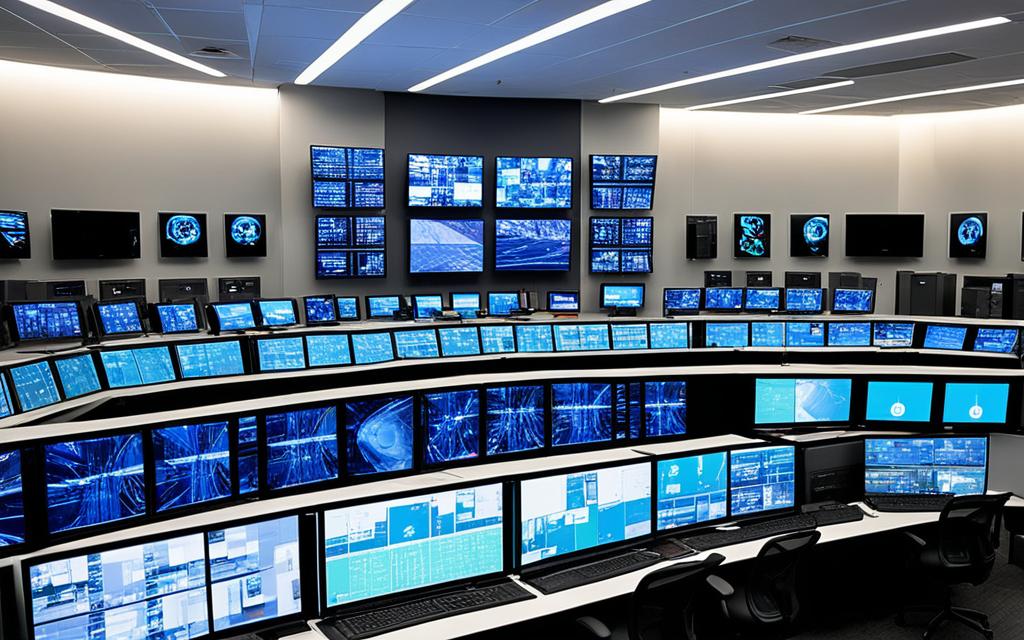
Video surveillance and monitoring systems provide continuous monitoring of data center environments. These systems utilize high-definition cameras strategically placed throughout the facility to capture and record activities in real-time. By closely monitoring the surroundings, any suspicious activities or security breaches can be detected promptly, enabling swift action and mitigating potential risks.
Perimeter Security: Guarding Against External Threats
Perimeter security measures are essential for protecting data centers against external threats. This includes physical barriers such as fencing, gates, and controlled entry points, as well as advanced technologies like motion sensors and intrusion detection systems. With robust perimeter security in place, data centers can prevent unauthorized access and effectively deter potential intruders, ensuring the safety and security of the entire facility.
Security Personnel: Human Vigilance and Expertise
While advanced security technologies are essential, the presence of trained security personnel is equally important in ensuring physical security. Security personnel provide human vigilance, monitoring activities, and responding to security incidents promptly. Their expertise and experience play a crucial role in maintaining a secure environment within the data center, working in collaboration with technological security measures to mitigate risks effectively.
Environmental Control: Beyond Intruders
Environmental control systems are crucial for maintaining optimal conditions within data centers. These systems regulate temperature, humidity, and airflow to ensure the proper functioning and longevity of critical hardware components. By maintaining a stable and controlled environment, data centers can prevent hardware failures and maximize operational efficiency.
The Importance of Secure Racks and Cabinets
Secure racks and cabinets provide an additional layer of physical security within data centers. These specially designed enclosures prevent unauthorized access to servers, switches, and other network infrastructure devices. Secure racks and cabinets often feature advanced locking mechanisms, tamper-proof construction, and controlled airflow to safeguard critical equipment from physical damage and unauthorized tampering.
In summary, data center physical security encompasses various measures, from access control systems and video surveillance to perimeter security, security personnel, environmental control, and secure racks and cabinets. Each element plays a crucial role in creating a secure and protected environment for valuable data and ensuring the uninterrupted operation of data centers.
Troubleshooting Fiber Optic Networks
Troubleshooting fiber optic networks requires a deep understanding of the fundamentals, installation processes, and network components. In this section, we will provide insights into the basics of fiber optics and discuss the necessary steps for troubleshooting network issues.
The Basics of Fiber Optics
Fiber optics is a technology that uses thin strands of glass or plastic to transmit data as pulses of light. There are two main types of optical fibers: single-mode and multi-mode. Single-mode fibers allow for long-distance transmission with minimal signal loss, making them ideal for telecommunication networks. On the other hand, multi-mode fibers are used for short-distance applications like LANs.
“Fiber optics offers numerous advantages over traditional copper cables. It provides higher bandwidth, faster data transmission, and is immune to electromagnetic interference.”
The structure of a fiber optic cable consists of the core, cladding, buffer, and jacket. The core is the central part that carries the light signals, surrounded by the cladding which helps keep the light within the core. The buffer provides protection to the core and cladding, while the jacket acts as the outer layer for mechanical and environmental protection.
Benefits of Fiber Optics
Fiber optics offers several benefits across various industries. In telecommunications, fiber optic networks provide faster internet speeds, enabling high-quality video streaming, voice calls, and data transfers. The healthcare industry benefits from ultra-fast connections for transmitting medical records, remote diagnostics, and telemedicine. Additionally, fiber optics is essential for data centers, enabling high-capacity data transfers and low-latency connections for cloud computing and storage.
Installation Process
The installation process for fiber optic networks involves several steps:
- Planning and Design: This step includes determining the network layout, identifying the required equipment, and creating a fiber optic design plan.
- Cable Preparation and Termination: Fiber optic cables need to be prepared and terminated properly to ensure optimal performance. This involves stripping the cable, cleaning the fibers, and attaching connectors.
- Testing for Performance Verification: After installation, testing the fiber optic network is crucial to verify signal integrity, detect any issues, and ensure optimal performance. This includes using specialized testing equipment to measure loss, reflectance, and other parameters.

Having a clear understanding of fiber optic troubleshooting, installation processes, and network components is vital for maintaining the performance and reliability of fiber optic networks. In the next section, we will explore the importance of proactive network uptime monitoring and the tools and strategies businesses can employ to stay ahead of network issues.
Conclusion
In conclusion, effective fiber optic network monitoring, proactive network uptime monitoring, physical security, and efficient troubleshooting are crucial components for establishing and maintaining a reliable and high-performing network infrastructure.
Proactive monitoring empowers businesses to anticipate and address network issues before they escalate, ensuring uninterrupted operations, enhanced business continuity, and heightened customer satisfaction.
Data center physical security plays a vital role in safeguarding valuable data and ensuring the smooth operation of equipment. By implementing access control systems, video surveillance and monitoring, perimeter security measures, and employing capable security personnel, businesses can fortify their physical security framework and protect their critical assets from potential threats.
Additio
FAQ
What is fiber optic network monitoring?
Fiber optic network monitoring involves the use of specialized tools and techniques to keep track of the performance and health of a fiber optic network. It allows businesses to detect and resolve issues proactively, ensuring the reliability and efficiency of their network infrastructure.
Why is proactive network uptime monitoring important?
Proactive network uptime monitoring is crucial for maintaining business continuity. By constantly monitoring the uptime of your network, you can identify potential issues before they escalate, minimizing network downtime and ensuring uninterrupted service for your customers.
What tools and strategies can help businesses with network uptime monitoring?
There are several tools and strategies available for businesses to ensure high network uptime. These include availability tracking and performance metrics, alerting and notification systems, downtime detection, proactive issue resolution, logging and reporting, and automation. By utilizing these tools and strategies, businesses can stay ahead of network issues and enhance their overall network performance.
Why is data center physical security important?
Data center physical security is crucial for protecting valuable data and maintaining the integrity of operations. Access control systems, video surveillance and monitoring, perimeter security, security personnel, and environmental control all play a role in ensuring the security of a data center. These measures help prevent unauthorized access, monitor activities, detect and address potential threats, and safeguard the equipment and information housed within the data center.
What are the key factors to consider in troubleshooting fiber optic networks?
Troubleshooting fiber optic networks requires a deep understanding of the basics of fiber optics, including the types of optical fibers and their advantages, the structure of fiber optic cables, and the benefits of fiber optics in different industries. Additionally, it is important to have knowledge of the installation processes, such as planning and design, cable preparation and termination, and testing for performance verification. By considering these factors, businesses can effectively identify and resolve issues in their fiber optic networks, ensuring optimal performance.


